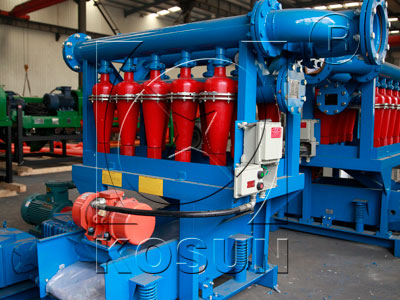KOSUN desilter for third stage of solids control system
2013-08-27
KOSUN desilter is used as the 3rd stage of solids control for drilling mud, which makes separations between 10 and 74 microns.
Technical Features of Kosun desilter:
1. 100% Polyurethane (PU) Material for desilter cones with longer using life
2. Clamp type for easy maintenance
3. Compact design with small footprint.
4. Flexible options for 8 or 10, 12, 16 for different capacities.
5. Flexible fast connection are available for user assembly.

Desilter uses smaller hydrocyclones usually 5″ or smaller. The smaller cones enable desilters to make the finest particle size separation of any full flow solids control equipment. Removing particles of 15 microns and larger. Multiple cones are normally used in this application to obtain the required GPM you need for your solids control system. When installing a desilter, follow these general recommendations:
1. Size the desilter to process 100-125% of the total mud circulation rate.
2. Take the desilter suction from the compartment receiving fluid processed by the desander.
3. Keep all lines as short & straight as possible.
4. Do not use the same centrifugal pump to feed both the desander & desilter. If both pieces of equipment are to be operated at the same time, they should be installed in series and each should have its own pump.
5. Direct the overflow line downward into the next downstream compartment at an angle of approximately 45%.
6. Keep the end of the discharge line above the surface of the mud to avoid creating a vacuum in the line.
7. Install a low equalizer line to permit backflow in to the desander section.
8. Install a guard screen over the suction with ½” slots to prevent large trash from entering the unit and plugging the cones.
Operating a desander ahead of the desilter takes a big load off the desilter and improves its efficiency. Operating desilter at peak efficiency is much the same as operating a desander. Here are a few fundamental principles to keep in mind.
1. Operate the desilter at the recommend pressure 32 – 40 PSI.
2. As solids increase, the cones bottom can be opened slightly to help increase solids removal.
3. Check cones regularly for bottom plugging or flooding, since a plugged cone allows solids to return to the active mud system.
4. If a cone bottom becomes plugged, unplug it with a welding rod or nail. If a cone is flooding it may need to be adjusted or the feed may be partially blocked off. It should also be inspected to make sure the cone is not worn out.
5. Run the desander continuously let fluid overflow back and process over & over.
Maintenance: A desilter’s smaller cyclones are more likely than a desander’s cones to become plugged with oversized solids, so it is important to inspect them often for wear & plugging. This may generally be done between bores, unless a failure occurs. The feed manifold needs to be flushed & checked for debris between bores.
News
- 07-11Technical features of using KOSUN drilling waste mud treatment system
- 07-07Main equipment of solids control system in drilling
- 06-26Geothermal well mud treatment system manufacturer—KOSUN solid control
- 06-26The key to achieving mud zero discharge is on-site processing after solid-liquid separation
- 05-10Application Scenarios of KOSUN Drilling Waste Treatment Equipment
- 05-10Environmental protection new regulations require to achieve zero discharge of drilling waste
- 05-09KOSUN Solid-liquid Separation Equipment is used in the construction industry
- 04-19What are the main functions of the Mud Agitator during use?
- 04-15The Advantages of KOSUN's trenchless horizontal directional crossing mud recovery system
- 03-15Vacuum degasser is mainly divided into centrifugal degasser and jet degasser




